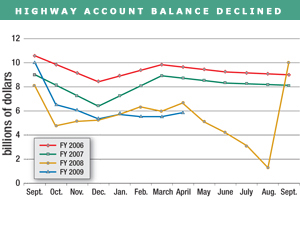The Highway Trust Fund is in trouble again. Last September, Congress rescued the fund’s highway account with an $8-billion injection. Now a new shortfall, estimated at $5 billion to $7 billion, is looming in August. The picture is even darker for 2010, when an additional $8 billion to $10 billion will be needed. The search is on for more revenue, but the White House is insisting that any new money for the trust fund must be offset, presumably by spending cuts or a revenue-raising mechanism.


“It’s a serious problem,” says Jay Hansen, National Asphalt Pavement Association vice president for government affairs. If nothing is done, the Federal Highway Administration will have to slow down its funding disbursements to state departments of transportation. That could put roadbuilding contractors in a cash squeeze while they wait for FHWA to release the money. “It just kind of ripples through the system,” says Hansen.
U.S. DOT Secretary Ray LaHood says Obama administration officials and congressional leaders have been meeting to come up with a solution. LaHood says the administration will propose a trust-fund remedy by mid-August. “It’s going to get fixed,” LaHood says. “Everyone’s committed to getting it fixed.” But so far, he isn’t saying what the fix will look like.
“I don’t think there are a whole lot of options out there,” says Brian Deery, senior director of the Associated General Contractors’ highway and transportation division. “The only thing they can do at this point is a general-fund transfer of money to keep it whole while they’re addressing the long-term problems when they get into reauthorization.”
Sen. James Inhofe (R-Okla.) suggests looking at the accumulated interest on the trust fund’s balance, which since 1998 has been flowing into the general Treasury, not the trust fund. Jack Basso, American Association of State Highway and Transportation Officials’ director for program, finance and management, estimates interest is $1 billion to $1.2 billion a year, or a total of about $10 billion since 1998. That would cover the 2009 problem, but not the projected gap for 2010.
A bigger potential target is the revenue lost to the trust fund from 1993 to 1998 when receipts from 4.3¢ of the 18.4¢-per-gallon federal gasoline tax were directed to the general fund to reduce the overall federal deficit. Giving the trust fund a “credit” for that foregone revenue would net $11 billion a year, or $55 billion over the 1993-1998 span, for the fund, Basso estimates.
The sticking point is, either of those alternatives would reduce general-fund revenue and increase the overall federal deficit. The White House maintains it wants any such general-fund loss to be offset.
“The administration is committed to paying for the $5 [billion] to $7 billion to ‘plus-up’ the trust fund,” LaHood told the House transportation appropriations subcommittee on June 4. “The administration is adamant about this.” But offsetting any infusion of money to the trust fund would require finding a way to increase other revenue, cut spending somewhere or a combination of both.
Increasing federal motor-fuels taxes, the trust fund’s prime revenue source, would solve the problem, but LaHood emphatically states the White House opposes that option. Reiterating a position he has voiced since taking the top DOT job, LaHood told the subcommittee, “The administration does not want to raise the gas tax. There are a lot of people out of work, and I think the last thing you want to say to people is, ‘We’re going to raise your gasoline taxes.’ ”
LaHood said officials are working on the issue. “There’s a lot of discussion going on. And it...



Post a comment to this article
Report Abusive Comment